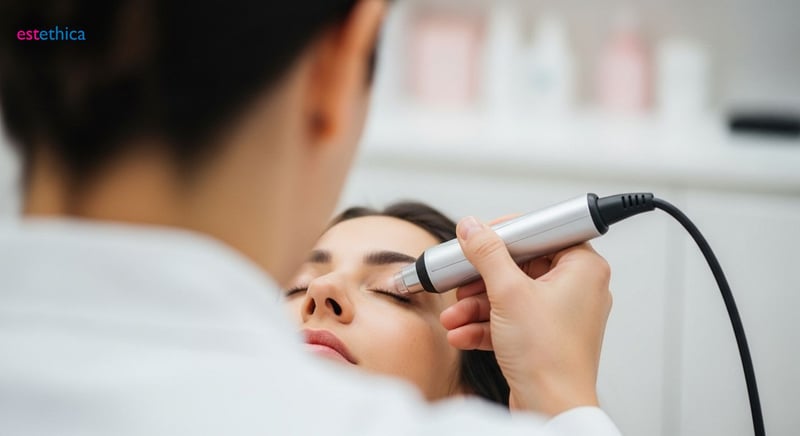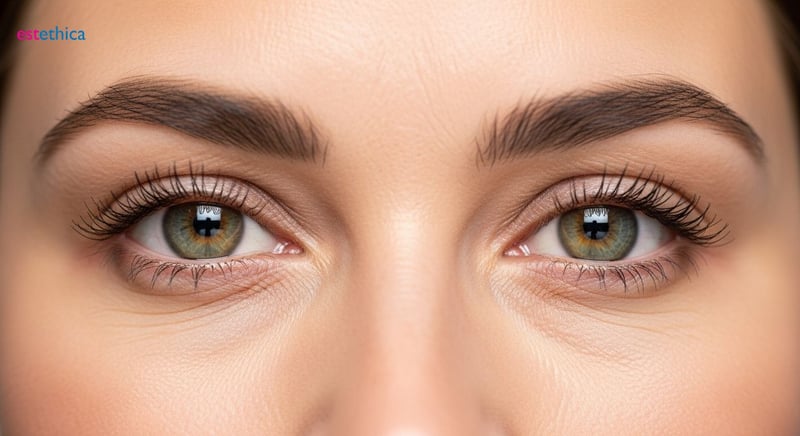Eyelid Surgery: Reclaim Youthful Eyes with Blepharoplasty
Enhance your eyes with blepharoplasty – an effective solution for youthful and vibrant eye aesthetics.
Eyelid surgery, also known as blepharoplasty, is a popular cosmetic procedure designed to enhance the appearance of the eyes by removing excess skin, fat, or muscle. This surgery can address issues such as droopy eyelids, under-eye bags, and might even improve your vision. Whether you're seeking cosmetic enhancement or relief from vision obstruction, blepharoplasty offers a transformative solution.
Understanding Upper and Lower Eyelid Surgery Options
Exploring the Nuances of Upper and Lower Eyelid Procedures
Eyelid surgery, or blepharoplasty, is a tailored approach to rejuvenate the eyes, addressing specific concerns in the upper and lower eyelids. Upper eyelid surgery primarily targets excess skin and fat that can cause drooping, potentially impairing vision and creating a tired appearance. It involves precise removal of these tissues to restore a more open and alert look. One study indicated that approximately 65% of people seeking upper eyelid surgery report improved peripheral vision post-procedure. For example, individuals experiencing difficulty with activities like driving or reading due to drooping eyelids might consider this option. Another example might be someone noticing that their heavy upper eyelids make them appear constantly fatigued, even when well-rested. Additionally, those who experience skin irritation due to the excess skin folding over the eyelashes might find relief through upper eyelid surgery.
Understanding Patient-Specific Benefits of Cosmetic Eyelid Surgery
Lower eyelid surgery, conversely, focuses on reducing puffiness and eliminating excess skin that leads to under-eye bags. This procedure often involves tightening the underlying muscles and repositioning or removing fat pads to create a smoother, more youthful contour. Tailoring the approach to each patient's individual needs is paramount, ensuring the results harmonize with their overall facial features. For instance, someone with prominent under-eye bags that do not respond to lifestyle changes like improved sleep or diet might be a suitable candidate. Another example is a person noticing significant skin laxity and wrinkles under the eyes, contributing to an aged or worn-out appearance. In fact, according to the American Society of Plastic Surgeons in 2023 patients who underwent lower eyelid surgery reported a 78% satisfaction rate with the reduction of under-eye bags and a more refreshed look. Also individuals troubled by dark circles caused by shadowing from puffy under-eye bags could see substantial improvement.

Am I a Candidate for Cosmetic Eyelid Surgery?
Key Factors That Define a Good Candidate for Cosmetic Eyelid Surgery
Ideal candidates for eyelid surgery are generally in good health, possess realistic expectations, and understand the potential outcomes of the procedure. These individuals are often seeking to correct specific aesthetic concerns, such as sagging upper eyelids or bags under the eyes, which can contribute to an aged or tired appearance. For example, someone who finds their vision is partially obstructed by excess upper eyelid skin might consider blepharoplasty to improve both their sight and appearance. Another individual might seek lower eyelid surgery to address persistent puffiness or dark circles that are resistant to cosmetic treatments. Additionally, individuals with a stable medical history who do not smoke and fully grasp the recovery process are usually better suited for achieving satisfactory results.
Essential Steps to Determine If Blepharoplasty Is Right for You
Determining whether you are a suitable candidate for cosmetic eyelid surgery involves a comprehensive evaluation and discussion with a qualified and experienced surgeon. This consultation is crucial for assessing your individual anatomy, understanding your specific goals, and setting realistic expectations. During the consultation, the surgeon will evaluate factors such as skin elasticity, muscle tone, and the underlying bone structure to determine the most appropriate surgical approach. For example, if you are considering an upper eyelid lift, the surgeon will assess the amount of excess skin and fat and discuss whether ptosis repair—a procedure to correct drooping eyelids—is also needed. To help ensure you are well-prepared for your consultation and have a clear understanding of what to expect from a blepharoplasty procedure, here are a few things to keep in mind:
- Medical History Review: The surgeon needs to know about any pre-existing conditions, allergies, or previous surgeries you've had. It’s crucial for minimizing risks.
- Medication Disclosure: Inform the surgeon about all medications, including over-the-counter drugs and supplements, because some can affect bleeding and healing.
- Lifestyle Factors: Discuss habits like smoking and alcohol consumption, as they can impact healing and surgical outcomes.

Eyelid Surgery for Droopy Eyelids: A Detailed Look
The Functional and Cosmetic Benefits of Ptosis Repair
Droopy eyelids, clinically known as ptosis, extend beyond mere cosmetic concerns; they can significantly impair one's field of vision and overall quality of life. Eyelid surgery offers a comprehensive solution by precisely tightening the muscles and tendons responsible for eyelid elevation, addressing both functional and cosmetic needs. This dual approach not only enhances the aesthetic appearance of the eyes, making them appear more alert and youthful, but also expands the visual field, improving daily activities such as reading, driving, and computer use. According to a study published in the "Journal of Ophthalmology," approximately 85% of patients who underwent ptosis repair reported a significant improvement in their visual field. For instance, someone who struggles with constant eye strain due to compensating for drooping eyelids may find considerable relief. Another example is an individual whose drooping eyelids interfere with their ability to perform tasks requiring clear peripheral vision. Additionally, patients often report increased self-esteem and confidence as a result of the rejuvenated appearance.
Advanced Techniques for Natural-Looking Eyelid Aesthetics
Modern eyelid surgery techniques prioritize delivering natural-looking results that seamlessly blend with the patient's overall facial harmony. Surgeons employ advanced methods, such as hidden incision techniques and meticulous tissue manipulation, to minimize scarring and achieve subtle yet impactful enhancements. These techniques ensure that the eyes maintain their natural shape and expression while appearing more refreshed and youthful. For example, estethica Global surgeons use micro-surgical instruments to ensure minimal trauma to the surrounding tissues, promoting faster healing and reduced swelling. Furthermore, 3D imaging technology aids in pre-operative planning, allowing for precise customization of the surgical approach to meet each patient's unique anatomical needs. The goal is to provide an outcome where patients look like a rejuvenated version of themselves, rather than appearing "overdone" or artificial. Consider a person who desires a subtle enhancement to correct asymmetry in their eyelids or someone seeking to restore a more youthful appearance without drastically altering their natural look. Here are key benefits of advanced eyelid surgery techniques:
- Minimal Scarring: Hidden incision techniques ensure scars are discreetly placed within the natural creases of the eyelids.
- Customized Approach: Advanced imaging and surgical planning allow for tailored solutions that match individual anatomical needs.
- Natural Results: Focus on subtle enhancements that maintain the natural shape and expression of the eyes.

Eyelid Surgery: Recovery Tips and What to Expect After Blepharoplasty
Navigating the Initial Days After Eyelid Surgery
In the immediate aftermath of eyelid surgery, it’s common to experience swelling and bruising around the eyes. This is a normal part of the healing process, and typically, these effects begin to subside within the first two weeks. To minimize discomfort and promote faster recovery, keeping your head elevated, especially while sleeping, can help reduce swelling. Applying cold compresses gently to the eye area for 15-20 minutes at a time, several times a day, can also provide relief. For example, consider using a bag of frozen peas wrapped in a soft cloth to avoid direct contact with the skin. Remember, patience is key during this initial phase. According to a survey conducted by the American Society of Plastic Surgeons, approximately 90% of patients felt comfortable resuming normal activities within two to three weeks post-surgery, when following their surgeon's aftercare instructions meticulously. Also using lubricating eye drops as prescribed helps prevent dryness and keeps the eyes comfortable. Furthermore, wearing sunglasses protects the sensitive skin around the eyes from sun exposure, which can delay healing and potentially cause hyperpigmentation.
Essential Aftercare Steps for a Smooth Blepharoplasty Recovery
Adhering to your surgeon's specific post-operative care instructions is crucial for ensuring a smooth and complication-free recovery after blepharoplasty. These instructions are tailored to your individual needs and the specifics of your surgery. Neglecting these guidelines can increase the risk of infection, delayed healing, or less-than-optimal cosmetic results. For instance, your surgeon may advise you to avoid wearing contact lenses for a certain period, typically one to two weeks, to prevent irritation and infection. Similarly, they might recommend avoiding strenuous activities like heavy lifting or vigorous exercise for several weeks to minimize swelling and bruising. Moreover, it’s essential to attend all scheduled follow-up appointments so that your surgeon can monitor your progress and address any concerns promptly. For example, if you notice any signs of infection, such as increased redness, swelling, or discharge, contacting your surgeon immediately is paramount. Additionally, some surgeons recommend gentle massage techniques to help reduce swelling and promote lymphatic drainage. Here are key aftercare steps to take following your cosmetic eyelid surgery:
- Follow Medication Instructions: Take all prescribed medications, such as antibiotics or pain relievers, as directed by your surgeon.
- Protect Incision Sites: Keep incision sites clean and dry, and avoid rubbing or scratching the area to prevent infection and scarring.
- Limit Screen Time: Reduce prolonged screen time to minimize eye strain and dryness during the initial recovery period.
Understanding Blepharoplasty: A Comprehensive Guide
Micro-Surgical Eyelid Techniques Delivering Natural-Looking Aesthetics
Personalized Eyelid Surgery Enhancing Recovery and Ensuring Natural Results
Frequently Asked Questions
What is Eyelid Surgery (Blepharoplasty) and what does it address?
How do I know if I'm a good candidate for Cosmetic Eyelid Surgery?
What can I expect during the recovery period after Eyelid Surgery?
How does Eyelid Surgery address droopy eyelids (ptosis), and what are the benefits?
Achieve your aesthetic goals with estethica's personalized treatment plans and expert care.
📞 Schedule Your Free Consultation!